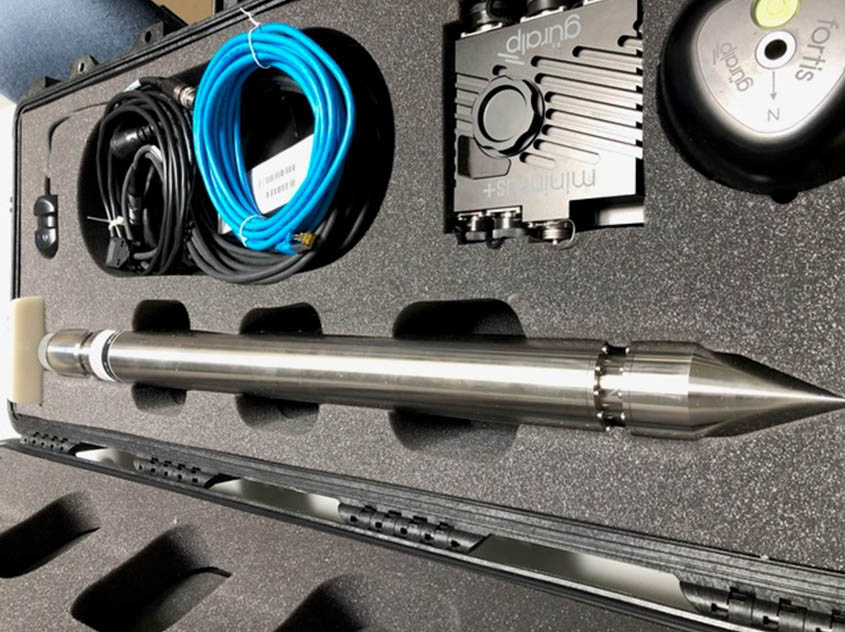The University of Évora (UÉ) is training the national seismic monitoring network to enable the development of an Early Warning System for Earthquakes (Earthquake Early Warning System – EEWS), including those generated in the Atlantic region adjacent to Portuguese territory. "This alert system is essential not only for Portugal, but also for Europe", stress its officials.
The four seismic stations, which are soon to be installed and will take place in the municipalities of Vila do Bispo and Aljezur, are equipped with broadband seismometers (BB Radian Posthole Guralp, 60s) to be installed in holes at a depth of 30 m, in order to minimize cultural noise.
In addition to the seismometers installed in depth, each station will also be equipped with an accelerometer (Guralp Fortis) installed on the surface. This accelerometer will be an important element for a more efficient characterization of the movements, mainly in situations of strong earthquakes where the seismometer registers can saturate. It is a very useful component, in particular, for EEWS purposes.
The system (EEWS) is based on the time interval between the primary seismic waves (referred to as P, faster) and the secondary waves (referred to as S, slower). The time interval is calculated from the propagation velocities of the P and S waves.
However, it must be stressed “that the S and surface waves are the most destructive”, explains Mourad Bezzeghoud, professor in the Department of Physics and researcher at the Institute of Earth Sciences at the University of Évora.
“The closer we are to the epicenter, the shorter the time interval (between P and S) and the closer we are to it, the more serious the damage is”, stresses the researcher from the Eborense Academy, since, “the closer we are from the epicenter, the less time we have to alert and react, and the further we are from it, the more time we have to react and take protective measures” adds Mourad Bezzeghoud.
The researcher emphasizes that, in the Portuguese case, time is counted in seconds or minute(s), “but there are other situations in the world where time can reach tens of minutes or even hours”.
The objective of this system implemented in our country, as Mourad Bezzeghoud underlines, is “to detect earthquakes and determine some of their characteristics, including location and magnitude, before the effects of strong earthquakes reach critical areas” and thus, in good time “ allow protection measures to be decided and implemented”.
It is through the EMSO-PT project - European Multidisciplinary Seafloor and Water Column Observatory, funded by the Portuguese state and the European Commission (Portugal 2020 programme), that the researchers intend to create and develop infrastructure for scientific and technological research in the scope of Marine Sciences and the Marine Environment and thus “expand the number of seismic stations on land , improving the national seismic monitoring network”.
This measure allows the creation of an early warning system for earthquakes, in particular for cases of tsunami.
The new seismic stations are linked to the research unit (ICT-UÉ) and to the national seismic network coordinated by the Portuguese Institute of the Sea and Atmosphere (IPMA).
“The location and magnitude are the main data through which it is possible to trigger some automatic security measures in critical situations, minimizing the destruction associated with events of this nature” highlights Mourad Bezzeghoud.
The researcher recalls that, in a situation similar to that of the 1969 earthquake, which hit the entire region of Portugal, northern Morocco and part of Spain, being the last major earthquake to occur in mainland Portugal, the system now implemented “would have the capacity to register the first waves that arrive at various points along the coastline, transmit them to a calculation center where the predictable effects of this earthquake are estimated and it is decided which automatic protection measures to implement in critical installations, minimizing the destruction associated with this event”.
Thus, the early warning of earthquakes allows triggering automatic safety mechanisms in critical installations, such as gas pipelines, high-speed trains, bridges, tunnels, minimizing the losses associated with the earthquake.
“The idea of these systems is to activate a series of automatisms to notify the security and emergency forces” adds the researcher in this regard.
Mourad Bezzeghou also recalls that the Eurasian and African (Nubian) tectonic plates converge and that it remains seismically and volcanically active, so “seismic monitoring of the region is essential not only for Portugal, but also for Europe.
Network densification is essential for a precise location of seismic events from the region located to the Southwest (SW) of Cabo de S. Vicente, as it is from this region that events with great potential for destruction are expected to occur.
"The unfavorable location of this seismogenic region requires increasing the network densification to detect, locate and accurately calculate the seismic parameters, namely the location and magnitude, as well as other parameters involved in the EEWS", summarizes the researcher from UE.
This project (EMSO-PT) whose system will be implemented involves IPMA, Vila do Bispo City Council, Aljezur City Council, Bordeira Parish Council and the Regional Directorate for Nature Conservation and Forests of the Algarve (ICNF) .



















Comments